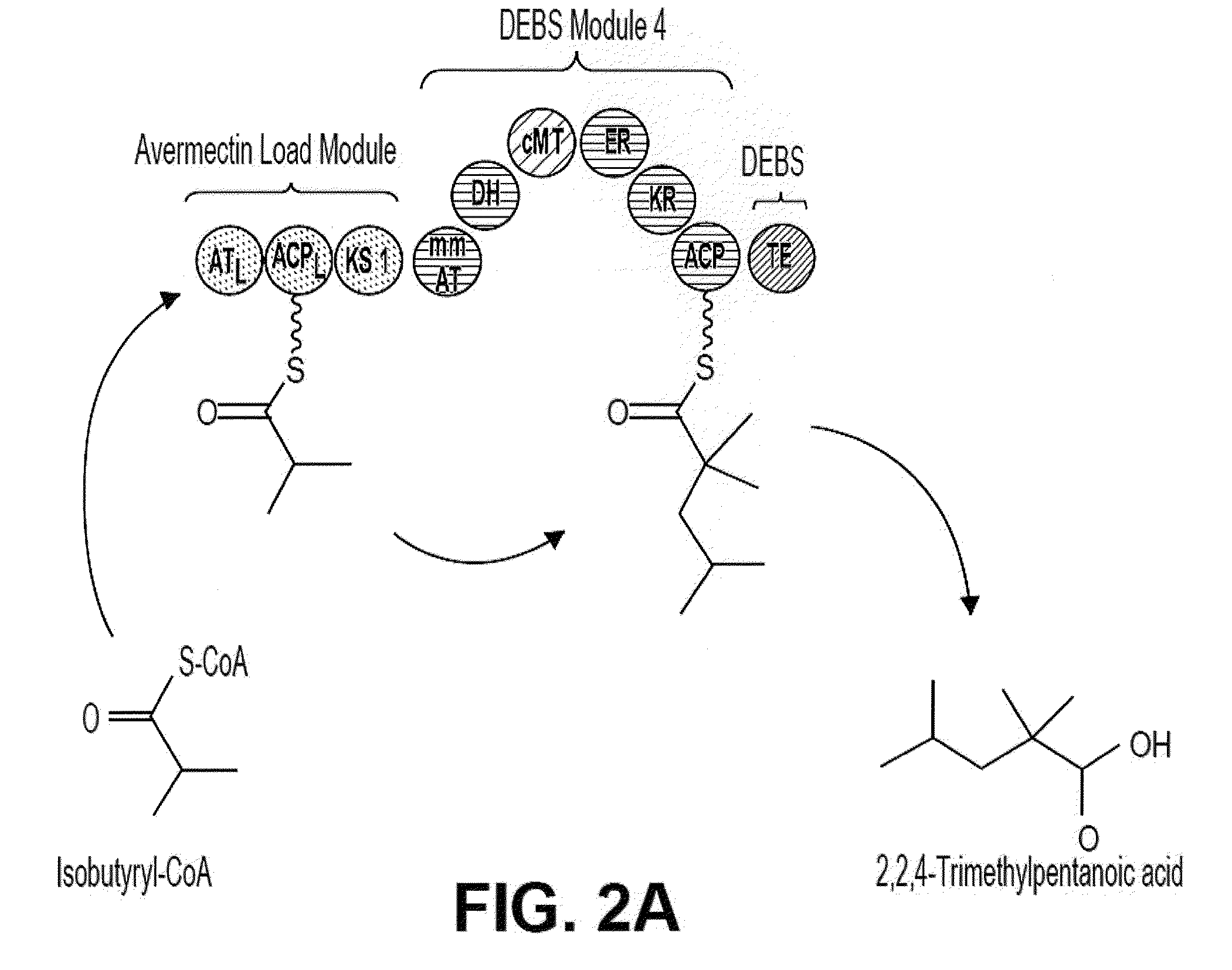Producing a Trimethylpentanoic Acid Using Hybrid Polyketide Synthases
- Summary
- Abstract
- Description
- Claims
- Application Information
AI Technical Summary
Benefits of technology
Problems solved by technology
Method used
Image
Examples
example 1
Production of Iso-Octane from 2,2,4-Trimethylpentanoic Acid Through Methylation of 2,4-Dimethyl Pentanoic Acid
[0076]PKS-A (FIG. 2) is designed to produce 2,2,4-trimethylpentanoic acid through the condensation of isobutyryl-CoA and 2-methylmalonyl-CoA, both of which can be produced intracellularly in the microbial host, followed by full reduction of the β-carbonyl formed from the condensation to the corresponding methylene center, followed by the methylation of the α-carbon. PKS-A is composed of a loading module and a single extender module. The loading module is from the avermectin (ave) PKS (from Streptomyces avermitilis) which accepts isobutyryl-CoA (Marsden, A. F., B. Wilkinson, J. Cortes, N.J. Dunster, J. Staunton, and P. F. Leadlay. 1998. Engineering broader specificity into an antibiotic-producing polyketide synthase. Science 279:199-202; incorporated by reference herein). The loading module from the lipomycin PKS also accepts isobutyryl-CoA (Bihlmaier C., E. Welle, C. Hofmann...
example 2
Production of Iso-Octane from 2,4,4-Trimethylpentanoate Produced by Condensation of Pivaloyl-CoA and Methylmalonyl-CoA
[0079]PKS-B (FIG. 3) is designed to produce compound 2 through the condensation of pivaloyl-CoA and methylmalonyl-CoA followed by full reduction of the β-carbonyl formed to the corresponding methylene center. PKS-B comprises a loading module and a single extender module and is similar to PKS-A with the exception that it does not contain the C-methylation domain present in the latter. The simplified design of PKS-B enables the construction from two contiguous, naturally-occurring segments: ATL-KS domains from the avermectin PKS and mmAT-ACP of module 4 of DEBS, or module 2 of the Nan PKS. The TE domain of the erythromycin PKS is added as the third component. As in the case of PKS-A, the construct is expressed as a single gene in E. coli. An abbreviated scheme for the biosynthesis of compound 2 catalyzed by PKS-B is illustrated in FIG. 3. The scheme shows the starter a...
example 3
Conversion of 2,2,4-Trimethylpentanoic Acid and 2,4,4-Trimethylpentanoic to Iso-Octane
[0082]Both 2,2,4-trimethylpentanoic acid and 2,4,4-trimethylpentanoic acid is reduced to the corresponding 1-alcohol by treatment with lithium aluminum hydride (LiAlH4). Subsequently, 2,2,4-trimethyl-1-pentanol and 2,4,4-trimethyl-1-pentanol are reduced to the corresponding alkane, 2,2,4-trimethylpentane (iso-ocatane) by treatment with sulfuric acid followed by treatment with hydrogen gas using a platinum catalyst. An alternative method is to first treat the alcohol with p-toluenesulfonyl chloride and then react the resulting tosylate with LiAlH4 to produce isooctane.
[0083]While the present invention has been described with reference to the specific embodiments thereof, it should be understood by those skilled in the art that various changes may be made and equivalents may be substituted without departing from the true spirit and scope of the invention. In addition, many modifications may be made t...
PUM
| Property | Measurement | Unit |
|---|---|---|
| Stability | aaaaa | aaaaa |
Abstract
Description
Claims
Application Information
 Login to View More
Login to View More - R&D
- Intellectual Property
- Life Sciences
- Materials
- Tech Scout
- Unparalleled Data Quality
- Higher Quality Content
- 60% Fewer Hallucinations
Browse by: Latest US Patents, China's latest patents, Technical Efficacy Thesaurus, Application Domain, Technology Topic, Popular Technical Reports.
© 2025 PatSnap. All rights reserved.Legal|Privacy policy|Modern Slavery Act Transparency Statement|Sitemap|About US| Contact US: help@patsnap.com



